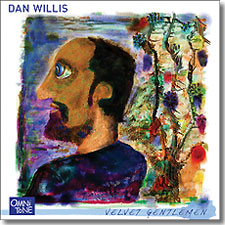Liner notes for Dan Willis: Velvet Gentlemen (OmniTone 15216)

"Before
I compose a piece, I walk around it several times,
accompanied by myself." —Erik Satie
"Science cannot solve the ultimate mystery of
nature.
And that is because, in the last analysis,
we ourselves are a
part of the mystery that we are trying to solve." —Max
Planck
Quantum physics' Heisenberg Uncertainty Principle presents a doozy of a paradox: that the more precisely we try to determine where particles are located in an atom, the less likely we are to know their whereabouts at any one time, sometimes known as the precision-randomness paradox. By the time you figure out where they are, they've moved.
It's like releasing a recording by a creative improvising musician — by the time the CD is released, the artist is off doing something else.
Multi-reedist and composer Dan Willis is no exception. As one of New York City's most active and versatile woodwind specialists, Dan performs regularly across a wide spectrum from jazz to New Music. In addition to his own ensembles, Dan is a member of the Grammy-nominated John Hollenbeck Large Ensemble and modernist classical chamber ensemble, Area 31. He has toured with Michael Brecker's Grammy-winning Quindectet and is active as well on Broadway and TV.
The beauty of working with a true creative musician like Dan, who comes out of the "jazz tradition," is that they work out of that tradition. They start with the basics, study the masters, get comfortable enough to let muse challenge technique, and then stretch beyond, seeking to transcend themselves and those around them through their art.
Dan's creative font not only springs forth from the cross-disciplinary musical training he received in oboe, composition, and jazz arranging as an undergraduate at Rochester's prestigious Eastman School of Music but stretches back further to a musical family lineage. With a violinist grandfather; a father who was a composer, trumpet player, and vibraphonist; and a pianist and a trombonist as brothers. Dan recalls, "there always was jazz and classical and rock — and a little bit of world music — going on when I was growing up."
Velvet Gentlemen, title of the album and one of its tracks, derives from the nickname Parisian children coined for Erik Satie (1866-1925). The eccentric and insightful composer, probably best known for his Gymnopédies piano pieces (one of which was even covered by Blood, Sweat & Tears) and considered by some to be a precursor Serialist composer, got the moniker because he was always seen strolling in his Parisian neighborhood wearing a velvet jacket.
Dan was taken by Satie's music when he heard recordings by Pascal Rogé played in the office of an accupuncturist he was seeing following an auto accident. "Hearing [Satie's] music really opened up my ears," admits Dan who, around the same time, also happened to read an article about saxophonist and composer Wayne Shorter's exploration of quantum physics. It inspired Dan to do some reading as well.
"So I got to thinking wouldn't it be amazing to go and hang out with Erik Satie and play over the top of his music while he's playing, because his music lends itself so well to jazz," recounts Dan. No doubt inspired by the fantastic possibilities for which quantum physics' space-time continuum allows, he thought he would like to write something that "could have one foot back in that time period, but also be, you know, now, sort of like ‘time travel.'"
The result, Velvet Gentlemen, combines compositional techniques inspired by Erik Satie's music and concepts of quantum theory with Dan's proclivity to create new timbres — using combinations of instruments not often heard in jazz, such as the Chinese suona, the Armenian duduk, and Western oboe and English horn.
The precision-randomness paradox is represented in loops of sound (such as in "Closed Loops in Time," titled after "a name that quantum physicists have for time travel") and in precise compositional loops that, when layered, present a façade of randomness. Dan creates loops using serialism, a technique that some say Satie's music presages, which takes rows of notes and varies them by playing them in reverse (retrograde), playing the pitch intervals in the opposite directions (inversion), or both.
Such musical loops weave their way throughout the pieces, sometimes multilayered as they are in "3:10 Local," with multi-tracked soprano sax and bass clarinet playing lines that are "twisted-up versions" of the bass part from Miles Davis' "Great Expectations."
That's not to say that all such devices leave the music cold or antiseptic; the effect is quite the contrary for these highly-skilled, musically-sympathetic collaborators, who use the compositions and arrangements as springboards to improvisation. In fact, the three shortest tracks on the record ("Nothing Is Real," "Uncertainty Relation," and "Grandparent Paradox"), started out as parts of an extended free improvisation that concluded the recording session. "The thing that struck me about the improvisation," notes Dan, " is that all these gentlemen were able to improvise in a vein in keeping with all the other compositions on the CD."
Perhaps what is most striking about Velvet Gentlemen is the way all of its eclectic influences and exotic sounds are woven together gracefully and elegantly. Erik Satie may have been known in the neighborhood for sporting lavish threads but, on this recording, Dan Willis and these gentlemen also do a fine job of comporting that certain je ne sais quoi.
—Frank Tafuri
©2018 OmniTone
